This post may contain affiliate links. Any sales made through such links will reward me a small commission – at no extra cost for you!
While you are obsessing over all the steps and benefits of Korean beauty routine, so popular at the moment, take a moment to sneak a peek at their overseas neighbors and their secret weapon – rice face masks – for preserving perfect, youthful looking skin…
Japanese women have learned centuries ago that rice face masks have a lot to give when it comes to skincare. I personally love DIY rice face masks. I love the effect that rice has on my skin – after a rice mask, my face feels super hydrated, plump and supple, smooth and even-toned and very – very – youthful!
Natural face masks with rice offer gentle, balanced care which, with consistency and persistence, leads to much better, longer lasting results than layering harsh, heavy products. Whether you use rice grains, rice water or rice flour, you can rest assured your skin is getting only the best organic nourishment.
12 Benefits of Rice Face Masks for Skin
- DIY skincare products with rice moisturize and brighten the skin and add dewy glow;
- Rice face masks smooth out dry, rough patches and make the skin incredibly soft;
- Rice collects excess oil without drying out the skin;
- It has anti-inflammatory properties, perfect for sensitive skin;
- Rice face masks minimize the pores and give you an even, matte complexion;
- They improve skin’s blood flow;
- Improve skin firmness and elasticity;
- Increase collagen production;
- Rice regenerates the skin and stimulates new cell growth;
- You can use it as a scrub, to exfoliate your skin;
- Rice contains ferulic acid, an antioxidant that protects the skin from free radicals;
- Rice face masks prevent premature aging signs and preserve youthful looking skin.
Top 10 DIY Rice Face Masks and Scrubs:
There are many ways you can use rice to enhance your beauty. One of the most popular ways is to make rice water.
Rice water has numerous benefits for your skin and hair. Here’s how to make it:
You can check my article on how I use rice water to make a face toner. Or go read all about my experience with using rice water hair rinse.
Here, however, we will focus on how to make natural rice face masks and scrubs:
1. Japanese Face Mask with Rice, Milk and Honey
- 3 teaspoons of boiled rice
- 2 teaspoons of honey
- 1 tablespoon of milk
This is one of the most nourishing DIY rice face masks. It rejuvenates the skin, brightens it and restores its healthy glow. It is also my personal favorite and I make it all the time, to quickly make my skin soft, smooth, supple and radiant.
Honey is one of the best natural ingredients, suitable for all skin types. It hydrates the skin without making it oily and has antibacterial, anti-inflammatory, antioxidant and healing effects. Milk exfoliates and lightens the skin and makes it plump and youthful.
Boil the rice until the grains are completely soft. Strain the rice and mash it with a fork until you get a smooth paste. Add the milk and honey and mix it all well.
Apply the mask to a clean face, preferably after a gentle face scrub. Leave it on for 20 – 30 minutes, then rinse off. Apply your face cream right away, to lock in the moisture.
2. Rice, Coconut Oil and Orange Juice Mask
- 2 tablespoons boiled rice
- 1 teaspoon coconut oil
- 2 teaspoons fresh orange juice
This face mask is perfect for dry, damaged or aging skin. It is highly moisturizing, nourishing and brightening. It repairs the skin’s natural barrier and improves its ability to retain moisture.
Boil the rice until soft. While it’s still hot, add the coconut oil and mash well until you get a smooth paste. In the end, mix in the freshly squeezed orange juice as well.
Apply the paste to your face and leave it on for around 20 minutes. Rinse off with lukewarm water and a gentle face cleanser. Apply a face moisturizer while your skin is still slightly damp.
3. Anti-Aging Rice Flour & Grapes Mask
- 2 teaspoons rice flour
- 3 – 4 grapes
- 1 – 2 drops vitamin E oil
Though all rice face masks have anti-aging properties, with this one the results are even faster and more noticeable. You can see how, with every use, your face becomes more supple, fine lines disappear, irregularities fade and your skin is getting that youthful glow.
Grapes provides your skin with moisture and many nutrients. Grapes’ skin contains resveratrol – a powerful antioxidant that can help prevent sun damage and photo aging. Orange juice replenishes the skin cells, protects the skin against free radicals and stimulates collagen production.
Blend the grapes with the skin until you get a smooth texture. Add just enough rice flour to get the consistency that you like – it shouldn’t be neither too thick nor too runny. Add vitamin E oil and mix well.
Wash and exfoliate your face, then apply the mask. Leave it on for 15 minutes and during that time reapply every time it starts to dry. Then rinse off the mask and apply your face cream.
4. Rice and Brown Sugar Face Scrub
- 2 teaspoons rice
- 1 tablespoon brown sugar
- 1 tablespoon olive oil
One of the best DIY face scrubs ever, for incredibly soft, bright and glowing skin! This scrub has a texture that is rough enough to remove all the dead, dry skin cells. But it is not too harsh, so it won’t damage your skin.
Grind the rice to a fine powder. Make it nice, fine and smooth; you don’t want anything sharp enough to scratch your skin. If you want your scrub to be extra gentle, you can grind the brown sugar as well.
If not, just mix the ground rice with brown sugar. Add just enough olive oil to get a texture similar to wet sand. Mix everything well.
Apply the scrub to your face. Using upward circular motions, gently exfoliate your skin for around 5 minutes. Then wash the scrub off and apply either a face mask or a face cream.
5. Rejuvenating Face Mask with Rice and Banana
- 1 tablespoon boiled rice
- 1 tablespoon mashed banana
- 2 teaspoons fresh lemon juice
Every now and then, your skin can get dehydrated, pale and dull. This can make you look tired and even up to 10 years older than you really are. But this face mask can quickly revitalize your skin and add some youthful glow to your cheeks.
Banana is a nourishing fruit that provides your skin with many minerals, vitamins and antioxidants. It softens the skin, makes it plump and improves its elasticity. Lemon brightens the skin and evens out the complexion.
To make this mask, put all the ingredients in a small bowl. Mash well with a fork until both rice and banana are smooth and creamy. Try to get rid of all the lumps, to get a smooth face mask.
Apply to a clean face, preferably after a gentle face scrub. Leave the mask on for around 20 minutes. Then rinse off and apply your face moisturizer while your skin is still slightly damp.
6. Rice & Avocado Face Mask for Sensitive or Combination Skin
- 2 teaspoons rice flour
- 1 large tablespoon mashed avocado
- 1 tablespoon fresh apple juice
If your skin is sensitive and prone to irritations, you have to be very careful about which products you are using. Commercial skincare often contains a lot of chemicals that can make sensitive skin even worse.
That is why your best choice would be to replace at least some commercial products with all-natural, homemade ones. And this mask is just perfect for sensitive skin – nourishing, moisturizing, soothing and healing.
To make the mask even more hydrating, you can use boiled rice instead of the rice flour. In either case, mix all the ingredients well until you get a nice, smooth paste.
Apply a thick layer of the mask evenly to your face. Leave it on for 15 – 20 minutes, then rinse off with lukewarm water. Apply a face moisturizer.
7. Rice & Green Tea Mask for Skin Imperfections
- 2 teaspoons boiled rice
- 1 teaspoon matcha green tea powder
- 2 – 3 teaspoons brewed green tea
Rice is one of the best things you can use to fade skin imperfections and get a bright, even complexion. Especially when you mix is with another restoring, soothing and healing ingredient, such as green tea.
Mash the rice until you get a smooth paste. Then add both matcha powder and warm green tea and mix everything well to get a thin, smooth paste.
Apply the mask after a face scrub. Apply a thin layer and reapply every time it starts to dry. Do this for 15 – 20 minutes. Then wash the mask off and apply your favorite face cream.
8. Brightening Face Mask with Rice, Aloe Vera & Orange Peel Powder
- 3 teaspoons boiled rice
- 1 tablespoon aloe vera gel
- 1 teaspoon orange peel powder
Though all rice face masks have skin brightening properties, aloe vera gel and orange peel powder take this effect to a whole other level. Plus, this mask is amazing in hydrating, rejuvenating and regenerating the skin.
Aloe vera is a natural healing agent that replenishes the skin, provides lots of antioxidants and reverses skin damages. Orange peel powder exfoliates the dry layer of the skin, lightens the complexion and makes the skin bright, youthful and glowing.
Mash the boiled rice until you get rid of all the lumps and get a smooth paste. Add the other two ingredients and mix well.
Apply as thick a layer of the mask as you can to a clean face. Leave it on for 10 – 15 minutes and during that time reapply the mask as necessary. Then wash the mask off with warm or lukewarm water and a gentle face cleanser. Apply a face moisturizer.
9. Diy Rice Face Mask with Honey and Cinnamon
- 1 large tablespoon boiled rice
- 2 teaspoons honey
- 1 teaspoon cinnamon
This face mask can help you treat several skin problems, including acne, acne marks, oily skin, dehydrated skin, dull complexion, dry, flaky skin, premature aging signs, etc.
However, cinnamon can cause allergic reactions when applied topically. So, before applying the mask to your face, make sure to patch-test it first.
To make the mask, use a fork to mash the rice until you get a smooth paste. Add the other two ingredients and mix everything well together.
Wash and gently exfoliate your face. Apply the mask in as thick a layer as you can. Leave it on for around 15 minutes and reapply every time your skin soaks it up. After 15 minutes, wash the mask off and apply a face cream.
10. Rice, Yogurt & Turmeric Face Mask for Acne Scars
- 2 teaspoons rice flour
- 3 – 4 teaspoons yogurt
- 1 teaspoon turmeric powder
This face mask fades acne marks and other skin imperfections and encourages the skin to heal and renew itself. But you can also use it just to refresh your face and add some glow.
Yogurt contains lactic acid, calcium, antioxidants and lots of moisture. It dissolves dead skin cells, removes the dull complexion, hydrates the skin and improves the skin tone. Turmeric improves the skin’s elasticity, soothes inflammations and stimulates the skin regeneration process.
To make this mask, all you have to do is mix all the ingredients well together. You should get a smooth paste. If your mask is too thick, you can add some more yogurt. If it is too thin, add more rice flour.
Apply the mask to a clean face and leave it on for around 15 minutes. During that time, don’t let the mask dry on your face – reapply as needed. After 15 minutes, wash the mask off first with warm, then with cool water.




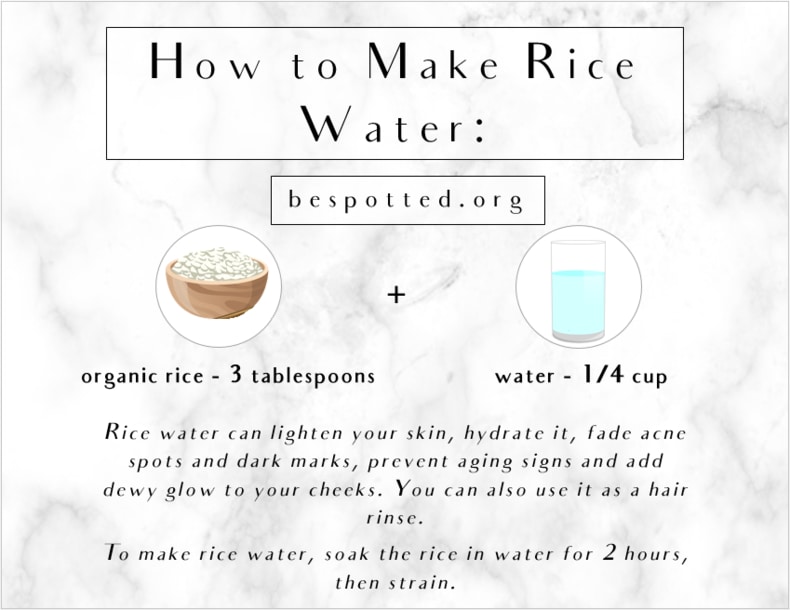












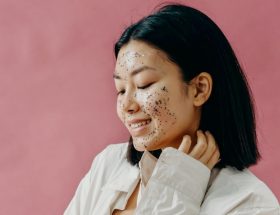

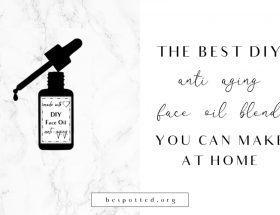

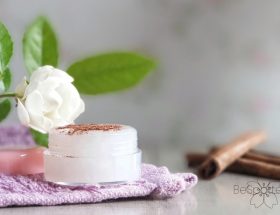


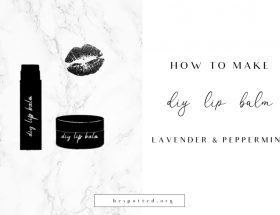

Hello. Where do I store the extra grounded rice I have made for masks and for how long?
Hi Jessica,
To be completely honest – I’m not sure. Since DIY products don’t contain preservatives and easily go bad, I like to prepare everything (well, not everything, but most stuff) right before I use them.
I guess you can grind some uncooked rice in a mortar or food processor and keep the powder in any clean jar – after all, we don’t refrigerate whole rice grains, right? But, this is just an opinion, I never tried to do that, so I can’t tell you for sure.
If you are talking about boiled rice, I also like to cook it fresh when I can. The most I kept it in the fridge was 4 – 5 days. For all I know, it might last for longer, but I’m honestly not sure.
Sorry I couldn’t help more with this, but if you have any more questions, feel free to ask anytime…
I’m really enjoying your blog and diy skin care. I find them very educational and I love how in depth you do into explaining all the steps. But the beginning of this post is very troubling to me having studied Japanese language and culture.
Geishas were not the definition of femininity. They were a type and profession. They are basically the equivalent of women in West Asian Harems, highly educated in wit, poetry, and other subjects to entertain men of high birth. Their skin comes from the cosmetics used to create the simplified appeal of the idea woman. While there is evidence to them using and creating skin care products, that is not what is depicted in historic prints and paintings of geishas.
I think it’s a disservice to geishas as defining them as just a preferred type of woman because even now they’re not what is expected of Japanese women. Modern and current Japanese society and culture focuses on women to drop most of the femininity associated with geishas and being a young girl for a more “mature” and “modern” woman. Please be a little more sensitive to the cultures you are deriving your skin care from because spreading the misinformation about geishas is disrespectful to all sex workers and escorts and creates potentially harmful stereotypes of Asian women to a mainly western audience you have.
Hi there,
Thanks for your support and kind words! ❤️️ And thanks for sharing your view on the subject. I’m sure many of us can learn a lot from it…
That was a really disappointing reply. Be better.
Is there a particular kind and brand of rice that you use and can recommend? Thanks!
Hi Anna,
I know that everyone recommends jasmine rice. So I tried it out and honestly – there is a difference, but only minimal. I’d say you can use pretty much any white rice you have on hand. As long as it is organic, to avoid the pesticides.
That really great artical…Thank you so much
Thank you… ️❤️️
thank you so much for sharing this precious information, I dont like to put chemicals on my face/skin. I am also ageing…lol…. so looking for natural ways for preserving the aged skin!!!!! i am looking forward to trying these out… I dont use honey (far to cruel the way its harvested!! nor do i use milk, for the same reason, im a vegan, but i have alternative i can use…. or just leave it out altogether). thanks once again,
Thank you so much! ❤️️❤️️❤️
I am not a vegan, but I am trying to give options and alternatives when possible. So out of curiosity – what is in your experience the best vegan substitute for honey?
Terrific article
Thanks! ❤️
:):):):):):):)
Absolutely! Rice contains ferulic acid, an antioxidant that protects the skin from free radicals Rice face masks prevent premature aging signs and preserve youthful looking skin.
🙌❤️️
how many times do we apply the rice face masks?
Hello, it depends on the mask and your skin type, but twice a week would be ideal.